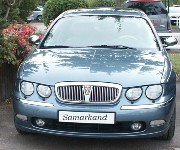Bernard wrote:The battery in our 75 has just given up. I probably shouldn't have left it for nearly 2 weeks unused.
It is the original battery, nearly 10 years old. I'm disappointed it didn't make it for a while longer like the one in the Transit featured in 'The Last Train'. That one was 50 years old when it started the truck.

Ford must use a better quality than Rover did.

I think the problem relates to all 'modern' cars consuming vast amounts of current, to a lesser extent when switched off, and the heavy demand on start up, especially on a diesel. Years ago, a car would probably start on a seriously discharged battery and if really flat, by using the starting handle. Jules recently told me how many amps are taken just by the ECUs and that's without HRW, Air-con, etc. Some cars will not start, even if the battery is showing just under 12 volts, possibly because voltage drop is associated with a vehicle being stolen and the ECU
(Engine Control Unit) immobilizes the engine. A fully charged battery should show 12 to 13 volts and to confirm the Alternator is charging, you should see about 15 volts with the engine running.
I often don't use my car for a while, especially in the winter, so I stick it on charge for a few hours at the weekend. To avoid keep taking off the battery cover, I have fitted a couple of Maplin's sockets, which allow easy access for charging and battery testing (see my book The 'Companion' in the 'Know How Forum' for a full explanation and illustration).
Roverite.

